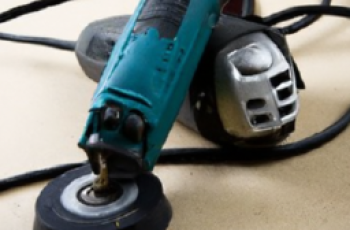If you’re interested in learning about die grinders, this article is for you! In this brief yet informative piece, we will explore the fundamentals of die grinders, providing you with a solid understanding of their purpose, usage, and key features. Whether you’re a beginner or a seasoned DIY enthusiast, this article will equip you with the knowledge you need to make informed decisions when it comes to die grinders. So let’s get started and dive into the world of die grinders!

What is a Die Grinder?
A die grinder is a handheld power tool that is commonly used in various industries, such as metalworking, woodworking, automotive, construction, and even for DIY projects. It is a versatile tool that is known for its ability to perform precision grinding, sanding, and polishing tasks. The die grinder gets its name from the shape of its grinder head, which is designed to fit into tight spaces and intricate patterns.
Definition
A die grinder is a power tool that is used for grinding, sanding, polishing, and other similar tasks. It typically consists of a motor, a grinding head, and various accessories or attachments for different applications.
Types of Die Grinders
There are two main types of die grinders: electric and pneumatic. Electric die grinders are powered by electricity, while pneumatic die grinders are powered by compressed air. Both types have their advantages and disadvantages, so it is important to consider your specific needs and preferences when choosing the right die grinder for your tasks.
How Does a Die Grinder Work?
To understand how a die grinder works, let’s take a closer look at its components, power source, rotational speed, and safety features.
Components of a Die Grinder
A typical die grinder consists of a motor, a grinder head, a collet, a switch, a speed control dial, and a handle. The motor is responsible for driving the grinder head, which is where the grinding, sanding, or polishing attachment is mounted. The collet is used to securely hold the attachment in place, while the switch and speed control dial allow you to turn the tool on/off and adjust the rotational speed.
Power Source
As mentioned earlier, die grinders can be either electric or pneumatic. Electric die grinders are typically powered by a cord that plugs into an electrical outlet, while pneumatic die grinders require a source of compressed air. The power source provides the energy needed to drive the motor and rotate the grinder head.
Rotational Speed
The rotational speed of a die grinder is measured in revolutions per minute (RPM). Different tasks and materials require different speeds, so it is important to choose a die grinder with adjustable speed settings. Lower speeds are generally used for precision tasks, while higher speeds are used for material removal.
Safety Features
Die grinders often come with safety features to protect the user. These may include a safety lock-off switch, which prevents accidental start-up, and a spindle lock, which allows for easy and safe changes of attachments. Some models may also have a built-in vibration reduction system or a soft-grip handle for added comfort and reduced hand fatigue during prolonged use.
Applications of Die Grinders
Die grinders are widely used in various industries and can be used for a wide range of applications. Here are some of the common applications of die grinders:
Metalworking
Die grinders are commonly used in metalworking tasks such as grinding, deburring, polishing, and shaping metal surfaces. They can be used to remove sharp edges, weld spatter, and excess material, and to achieve a smooth and polished finish on metal workpieces.
Woodworking
In woodworking, die grinders are often used for shaping, sculpting, and sanding wood surfaces. They are particularly useful for intricate and detailed woodworking projects that require precision and control. Die grinders can also be used to remove paint, varnish, or other coatings from wood surfaces.
Automotive
Die grinders are widely used in the automotive industry for various tasks such as grinding, sanding, and polishing metal and plastic surfaces. They are commonly used for automotive bodywork, engine porting, valve grinding, and other repair and maintenance tasks.
Construction
In the construction industry, die grinders are used for tasks such as cutting, grinding, and polishing masonry, concrete, and other construction materials. They are particularly useful for shaping and smoothing rough surfaces, removing mortar, or preparing surfaces for painting or other finishing treatments.
DIY Projects
Die grinders are also popular among DIY enthusiasts for various home improvement and crafting projects. They can be used for tasks such as grinding, sanding, and polishing metal, wood, or plastic surfaces, as well as for general-purpose maintenance and repair tasks around the house.
Choosing the Right Die Grinder
When it comes to choosing the right die grinder for your needs, there are several factors to consider. These include the power source, size and weight, speed, accessories and attachments, and ergonomics.
Power Source
The power source of the die grinder will depend on your specific requirements and preferences. Electric die grinders are generally more powerful and provide consistent performance, but they may be limited by the length of the power cord. Pneumatic die grinders, on the other hand, offer greater portability and are not limited by a power cord, but they require a source of compressed air.
Size and Weight
The size and weight of the die grinder can have a significant impact on its usability and comfort during prolonged use. Consider the size and weight that you can comfortably handle, especially if you will be using the tool for extended periods of time. Smaller and lighter die grinders are generally easier to maneuver and control, especially in tight spaces or when working on intricate details.
Speed
The rotational speed of the die grinder is an important factor to consider, as different tasks and materials may require different speeds. Look for a die grinder with adjustable speed settings to ensure versatility and adaptability to various applications. Higher speeds are typically used for material removal, while lower speeds are suitable for precision tasks.
Accessories and Attachments
Consider the variety and availability of accessories and attachments that are compatible with the die grinder you are considering. Different attachments are designed for specific tasks and materials, so having a wide range of options can greatly enhance the versatility of your die grinder. Look for a die grinder that offers a selection of accessories and attachments for your specific needs.
Ergonomics
The ergonomics of the die grinder are vital for user comfort and minimizing fatigue during prolonged use. Look for features such as a comfortable handle with a soft-grip coating or an ergonomic design that allows for a secure and comfortable grip. Additionally, consider features such as a vibration reduction system or a lightweight design to reduce hand fatigue and improve control.

Safety Precautions and Proper Use
Using a die grinder safely is of utmost importance to prevent accidents and injuries. Here are some safety precautions and proper use guidelines to follow:
Protective Equipment and Clothing
Always wear appropriate personal protective equipment (PPE) when operating a die grinder. This includes safety glasses or goggles to protect your eyes from flying debris, a dust mask or respirator to protect your lungs from airborne particles, and ear protection to reduce noise exposure. Additionally, wear appropriate clothing to protect your body and avoid loose-fitting clothing or jewelry that could get caught in the tool.
Workspace Preparation
Before using a die grinder, ensure that your workspace is clean, well-lit, and properly ventilated. Remove any potential hazards, such as flammable materials or clutter, that could pose a risk during operation. Secure your workpiece or material firmly in place to prevent it from moving or slipping during grinding.
Secure Workpiece
Always make sure that your workpiece is securely clamped or held in place before starting the die grinder. This will prevent the workpiece from shifting or flying off during operation, reducing the risk of accidents or injuries.
Proper Grinding Techniques
Use proper grinding techniques to ensure safety and achieve optimal results. This includes maintaining a firm grip on the die grinder, using even and consistent pressure, and moving the grinder in a controlled and steady motion. Avoid applying excessive pressure or forcing the grinder, as this can lead to overheating, tool damage, or kickback.
Maintenance and Cleaning
Regularly inspect and maintain your die grinder to ensure its optimal performance and longevity. Clean the tool after each use to remove any dust, debris, or residue that may accumulate. Lubricate moving parts and check for any loose or damaged components. Follow the manufacturer’s guidelines for maintenance and cleaning to prolong the lifespan of your die grinder.
Advantages of Die Grinders
Die grinders offer several advantages over other power tools, making them a popular choice in various industries. Here are some of the key advantages of using a die grinder:
Versatility
Die grinders are incredibly versatile tools that can be used for a wide range of applications. They are capable of performing tasks such as grinding, sanding, polishing, shaping, and even cutting, allowing you to tackle various projects with a single tool.
Precision
Die grinders are known for their precision and ability to work on intricate details. They can easily access tight spaces and maneuver around complex shapes, making them ideal for tasks that require precise control and accuracy.
Efficiency
With their high rotational speeds, die grinders are incredibly efficient at material removal. They can quickly remove excess material, sharp edges, or weld spatter, saving you time and effort compared to manual grinding or sanding techniques.
Portability
Depending on the type of die grinder you choose, they can be highly portable. Electric die grinders offer the convenience of being able to work anywhere with access to electricity, while pneumatic die grinders can be easily transported to different job sites as long as there is a source of compressed air.
Cost-effectiveness
While die grinders may require an initial investment, they are generally more cost-effective in the long run compared to manual tools or specialized power tools for specific tasks. With the versatility and efficiency of die grinders, you can save time and money by completing multiple tasks with a single tool.

Common Mistakes to Avoid
To ensure the optimal performance and longevity of your die grinder, avoid these common mistakes:
Using the Wrong Accessories
Using accessories that are not intended for use with your die grinder can lead to poor performance, damage to the tool or workpiece, or even accidents. Always use accessories and attachments that are recommended for your specific die grinder model and the task at hand.
Applying Excessive Pressure
Applying excessive pressure to the die grinder can lead to overheating, premature wear and tear, or even physical injury. Let the tool’s speed and the appropriate accessory do the work for you, and avoid using excessive force.
Ignoring Safety Precautions
Neglecting to wear appropriate personal protective equipment (PPE) or ignoring safety precautions can lead to serious accidents or injuries. Always follow the safety guidelines provided by the manufacturer and use common sense when operating a die grinder.
Not Maintaining the Die Grinder
Proper maintenance is crucial for the optimal performance and longevity of your die grinder. Regularly clean the tool, lubricate moving parts, and check for any loose or damaged components. Ignoring maintenance can lead to reduced performance, premature failure, or even safety hazards.
Using the Incorrect Speed
Using the incorrect rotational speed for a particular task or material can result in poor performance or damage to the tool or workpiece. Be sure to adjust the speed of your die grinder according to the specific requirements of the task at hand.
Tips and Tricks for Effective Die Grinding
To make the most of your die grinder and achieve optimal results, consider these tips and tricks:
Start with the Right Accessories
Choose the appropriate accessories and attachments for the specific task and material you will be working on. Different materials may require different types of abrasives or cutting attachments. Starting with the right accessories will ensure efficient and effective grinding.
Maintain Proper Speed
Adjust the rotational speed of your die grinder according to the task at hand and the material you are working on. Lower speeds are generally used for precision work, while higher speeds are suitable for material removal. Ensure that you are using the correct speed for optimal performance and safety.
Ensure Stability and Control
Maintain a firm grip on the die grinder and ensure that you have proper stability and control. Use both hands when operating the tool and position yourself in a comfortable and stable position. Avoid awkward or uncomfortable positions that could affect your control of the tool.
Follow Correct Grinding Techniques
Mastering the correct grinding techniques can greatly enhance the efficiency and quality of your work. Use consistent and even pressure, and move the grinder in a smooth and controlled motion. Avoid grinding in one spot for too long to prevent overheating and excessive material removal.
Regularly Clean and Lubricate
Regularly clean your die grinder after each use to remove any dust, debris, or residue that may accumulate. Lubricate moving parts as recommended by the manufacturer to ensure smooth operation. Proper cleaning and lubrication will help prolong the lifespan of your die grinder and maintain its optimal performance.
Popular Brands and Models
When it comes to choosing a die grinder, there are several popular brands and models to consider. Here are a few notable ones:
Brand 1
Brand 1 offers a range of high-quality die grinders that are known for their durability, performance, and versatility. Their die grinders come in various sizes and power options to suit different applications and preferences.
Brand 2
Brand 2 is renowned for its precision and innovation in the power tool industry. Their die grinders are designed with advanced features, such as variable speed control and ergonomic handles, to provide maximum comfort and performance.
Brand 3
Brand 3 is a trusted name in the automotive industry and offers a wide range of die grinders specifically designed for automotive applications. Their die grinders are known for their power, reliability, and durability in demanding environments.
Brand 4
Brand 4 specializes in pneumatic tools, including die grinders. Their die grinders are praised for their high-speed performance, lightweight design, and durability. They offer a variety of models to suit different needs and preferences.
Brand 5
Brand 5 stands out for its range of electric die grinders that offer excellent power, versatility, and ease of use. Their die grinders are praised for their consistent performance and durability, making them a popular choice among professionals and DIYers alike.
Conclusion
Die grinders are versatile and powerful tools that can greatly enhance your grinding, sanding, and polishing tasks in various industries and applications. By understanding the components, power source, rotational speed, and safety features of a die grinder, you can make an informed decision when choosing the right tool for your needs.
Remember to always prioritize safety by wearing appropriate protective equipment, preparing your workspace, and following proper grinding techniques. Regular maintenance and cleaning will help prolong the lifespan of your die grinder and ensure optimal performance.
With their versatility, precision, efficiency, portability, and cost-effectiveness, die grinders are an essential tool for professionals and DIY enthusiasts alike. Whether you are working with metal, wood, or other materials, a die grinder can help you achieve the desired results efficiently and effectively. Embrace the advantages of die grinders and enjoy the convenience of a tool that can tackle various tasks with ease.



